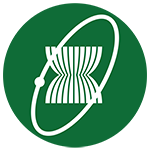DEVELOPMENT OF INSTANT KITS FOR 99MTc-LABELLING OF ANTI-CEA MONOCLONAL ANTIBODY AND HUMAN IMMUNOGLOBULINS FOR SCINTIGRAPHY.
Abstract
Simplicity and rapidity are highly desirable features in the development of 99mTc-labelled radiopharmaceuticals. On the basis of 2-mercaptoethanol reduction, three instant kits were formulated for preparation of 99mTc-labelled anti-CEA monoclonal antibody (IOR-CEA) used in the detection of colorectal cancers and 99mTc-labelled immunoglobulins (Sandoglobulin and Venoglobulin) for imaging of infection / inflammation in musculoskeletal system. The kits were sterile and demonstrated to be pyrogen free and had a shelf life of at least 1 year. Efficient labelling (>95% efficiency) could be achieved in 15 min at room temperature. All radiolabelled products exhibited 4-hour biodistribution patterns similar to those reported in literatures, i.e high blood background owing to long half life of IgG in plasma and high renal uptake because of in vivo cysteine transchelation. IOR-CEA was more resistant to cysteine challenge than Sandoglobulin and Venoglobulin. This facilitated the abdominal imaging using IORCEA. While the high renal activity in associating with Sandoglobulin and Venoglobulin did not interfere with the investigation of extremities. The costs for kit preparation were 40 times cheaper than those from commercial sources.
The instant kits developed in this study permitted the expensive radioimmunoscintigraphy within the reach of developing countries like Thailand where per capita incomes are far below the global standard.
Downloads
Metrics
References
Britton KE. Towards the goal of cancerspecific imaging and therapy. Nucl Med Commun 1997; 18:992-1007.
Chianelli M, Mather SJ, Martin-Comin J, Signore A. Radiopharmaceuticals for the study of inflammatory processes. A review. Nucl Med Commun 1997; 18:437-55.
Reilly RM. Immunoscintigraphy of tumours using 99mTc-labelled monoclonal antibodies : areview. Nucl Med Commun 1993; 14 : 347-59.
Mather SJ, Ellison D. Reduction-mediated technetium-99m labelling of monoclonal antibodies. J Nucl Med 1990; 31 : 692-7.
Boonkitticharoen V, Puchinda D, Ngonrath Na Ayudhya A, Kraiphibul P. Factors affecting chemistry of reduction - mediated 99mTc-labelling of monoclonal antibodies and immunoglobulins. J Med Assoc Thai (In press).
Boonkitticharoen V, Puchinda D, Chouplywech P, Jalayondeja W. Reduction-mediated 99mTc-labelling of antitumor monoclonal antibodies : Effect of increasing specific activity on antibody binding kinetics. J Med Assoc Thai 1998; 81:74- 9.
Robbins PJ. Chromatography of Technetium-99m Radiopharmaceuticals A Practical Guide. New York : The Society of Nuclear Medicine Inc, 1984.
Throll JH, Freitas JE, Swanson D, et al. Clinical comparison of cardiac blood pool visualization with Tc-99m red blood cells labelled in vivo with Tc-99m human serum albumin. J Nucl Med 1976; 19: 796-803.
Hnatowich DJ, Virzi F, Winnard P, Fogarasi M, Rusckowski M. Investiga tions of ascorbate for direct labelling of antibodies with technetium-99m. J Nucl Med 1994; 35 : 127-34.
United States Pharmacopia. 22nd ed, Rockville : Mack Printing Co., 1989; 1493-5.
Mardirossian G, Wu C, Rusckowski M, Hnatowich DJ. The stability of 99mTc directly labelled to an Fab’ antibody via stannousion and mercaptoethanal reduction. Nucl Med Commun 1992; 13:503-12.
Ponto JA, Swanson DP, Freitas JE. Clinical manifestations of radiopharmaceutical formulation problems. In: Hladik WB, Saha GB, Study KT, eds. Essentials of Nuclear Medicine. Baltimore : William & Wilkins, 1987; 268-89.
Alpha Therapeutic Corporation. Venoglobulin-I. Product Monograph. Los Angeles : 1991.
Vanbilloen HP, Verbeke KA, De Roo MJ, Verbruggen AM. Technetium-99m labelled human serum albumin for ventriculography : a comparative evaluation of six labelling kits. Eur J Nucl Med 1993; 20: 465-72.
Sirisriro R, Boonkitticharoen _ V, Kraiphibul P, et al. Detection of colorectal carcinoma by anti-CEA monoclonal antibody (IOR-CEA1) labelled with 99mTc scintigraphy. Hepato-Gastroenterol ( In press).
Sritara C, Sinphurmsukskul =O, Boonkitticharoen V, et al. Clinical evaluation of technetium-99m labelled human polyclonal immunoglobulin G for imaging of bone and joint infection. Asean J Radiol (Submitted for publication).
Oster ZH, Som P, Rhodes BA, et al. Abscess scintigraphy with 99mTc-human immunoglobulin (IgG) using a one-step labelling method. Nucl Med Biol 1993; 20: 225-30.
Dormehl IC, Louw WK, Hugo N. Biodistribution and accumulation in inflammatory lesion of different thiol reductionmediated 99mTc-IgG preparations in baboon model. Nucl Med Commun 1994; 15: 475- 82.
Gooden CSR, Snook DE, Maraveyas A, Rowlinson-Busza G, Peters AM, Epenetos AA. Direct technetium-99m labelling of three anticancer moroclonal antibodies : Stability, pharmacokinetics and imaging. J Nucl Med 1995; 36: 842-9.
Claessens RA, Boerman OC, Koenders EB, et al. Technetium-99m labelled hydrazinonicotinamido human _ non-specific polyclonal immunoglobulin G for detection of infectious foci: a comparison with two other technetium-labelled immunoglobulin preparations. Eur J Nucl Med 1996: 23:414-21.
Beatty JD, Beatty BG, O’Conner-Tressel M, etal. Mechanisms of tissue uptake and metabolism of radiolabelled antibody-Role of antigen : antibody complex formation. Cancer Res (Suppl) 1990; 50: 8408-458.
Kerr MA, Thorpe R. Immunochemistry. The LABFAX series. Oxford: Blockwell Scientific Publications, 1994.
Hawkins EB, Pant KD, Rhodes BA. Resistance to direct Tc-99m-protein bond to transchelation. Ant Immun Radiopharm 1990; 3: 17-25.
Aebi S, Assereto R, Lauterburg BH. Highdose intravenous glutathione in man. Pharmacokinetics and effects of cysteine in plasma and urine. Eur J Clinical Invest 1991; 21: 103-10.
Cooper AJL. Biochemistry of sulfur-containing amino acids. Ann Rev Biochem 1983; 52: 187-222.
Calame W, Feitsma HI, Ensing GJ, et al Detection of a local staphylococcal infection in mice with technetium-99m-labelled polyclonal human immunoglobulin. J Nucl Med 1991; 32: 468-74.
Hopkins SJ. Sandoglobulin. Drugs of Today 1985; 21: 279-82.
Downloads
Published
How to Cite
Issue
Section
License
Copyright (c) 2023 The ASEAN Journal of Radiology

This work is licensed under a Creative Commons Attribution-NonCommercial-NoDerivatives 4.0 International License.
Disclosure Forms and Copyright Agreements
All authors listed on the manuscript must complete both the electronic copyright agreement. (in the case of acceptance)













